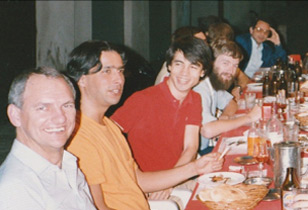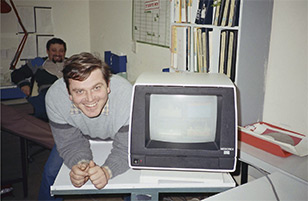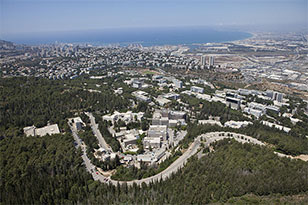|
Hear an Early LISTSERV Administrator Talk About Campus Email, Wartime Alerts and More
By Susan Brown Faghani
Manager, Marketing and Sales Communication, L-Soft
In a previous issue, Moshe Barak shared perspectives on email lists as a tool for activism and advocacy. Three decades before his work to protect health and the environment from near-shore gas drilling, Barak was one of the earliest LISTSERV site administrators, based at Technion-Israel Institute of Technology. Hear his unique insights on everything from email before LISTSERV to campus emergency alerts during wartime.
 Moshe Barak with Eric Thomas, LISTSERV Inventor and L-Soft Founder and CEO, in 1988
You're one of the longest-time users of LISTSERV. When and how did you find out about it for the first time?
I was a site admin since Day 1 and worked with LISTSERV for many years at Technion, starting in 1986.
Up until LISTSERV, there wasn't a way to mass communicate with people. At the time, email was only used for one-on-one communication. Communication flowed through a special set of tools, most inside the world of IBM machines worldwide, which was quite cumbersome. It was very hard to reach local users without the concept of a mailing list.
Only with the idea and implementation of the mailing list – Eric Thomas being first to do it worldwide – did mass communication become very thorough and proficient. I met Eric in-person in 1987 or 1988 through one of the EARN meetings in Turkey, and we knew each other before that through what was called BITNET, the IBM academic international network.
 Moshe Barak,
Early LISTSERV Site Administrator at Technion
What did your work with LISTSERV at Technion involve and how did it evolve?
From the beginning, we could create interest lists, for example, for faculty support staff, or to help with other system tasks. With time, at Technion, we built a system so that every academic course (3000 of them last time I was there) is automatically loaded at the beginning of each semester with students, and the academic staff as list owners. At the end of each semester, the recipients for each course are automatically reset so instructors can send messages to new students. Class message topics range from administrative information to course materials.
Because it was so convenient, we also started using LISTSERV lists for administrative purposes, with many hundreds of lists for academic staff, deans, administrative managers, human resources and employees. They were mostly announcement-only lists, plus some discussion lists. Each faculty department has its own three to five mailing lists for staff members and for department committees, for example, staff appreciation. There is also a superlist of everyone at Technion – all students and all faculty and staff.
Quite some time ago, I also introduced via the Topics keyword, the option to send text/SMS via email. All cell phone numbers of students and staff who opted for it were added to the relevant mailing list as members (e.g 0544876398@mailforu.com). So each message was sent via the SMS gateway and then transmitted as a text message to the recipients' cell phones.
 Credit: Technion / Israel Istitute of Technology
How did you use LISTSERV for emergency communications?
We have had in Israel, and still face, unfortunately, times of war. Technion was shut down in the past when missiles hit Haifa. We used both the LISTSERV mailing list and the LISTSERV-based email-as-text service to notify students about emergencies. Higher management had to make a decision: With 20,000 people on campus, it's not always simple to provide shelters to everyone. Technion was closed, and everyone was notified each day.
This system is used for other "emergencies" such as last-minute course cancellations, so a student gets a text message that saves him or her the trip to campus for a cancelled class.
Did you imagine then that you would still be working with LISTSERV more than 30 years later?
For me it was a natural thing because I noticed LISTSERV was constantly being upgraded, and if you think about it, there aren't too many software packages that have existed that long. It's a fantastic tool, so of course it will be there. Each version has newer and more features, many that the users themselves ask for. It becomes faster and more versatile and robust and is available on many platforms and OS. If LISTSERV tells us there's a problem, I trust LISTSERV. LISTSERV is always "right" and doesn't break from my experience. Such excellent programs are hard to find these days.
The introduction of the web interface made it easier for people who didn't have any expertise in command vocabulary, giving it a shorter learning curve. If you need to work with large-volume mailing lists, you don't really have an option other than LISTSERV because of its stability and speed. Others can get choked with high volume.
There's full and very fast support from L-Soft. L-Soft support, with whom I have been working now for years, close to three decades actually, deserve special appreciation. They're always polite, patient, and above all, always provide full and clear explanations and solutions to the problems they're sent. Each and every one is a true professional. If I may, I'd like to take this opportunity and thank all of the support people I have been working with during the years. You have been many times a lifesaver on critical tasks, and I highly appreciate your attitude and level of professionalism. Thank you so much!
Obviously, there's also the added value of a company that supports and gives back to society within which is operates. There aren't too many companies who do that out of the real sense and understanding of the power of giving back. Good old values, we will all probably miss.
Explore how LISTSERV powers colleges and universities:
http://www.lsoft.com/products/listserv_on_campus.asp
Subscribe to LISTSERV at Work.
|